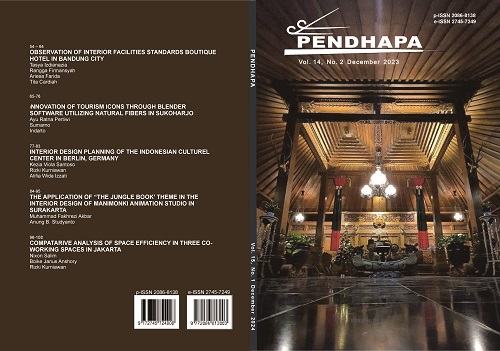The Application of “The Jungle Book” Theme in the Interior Design of Manimonki Animation Studio in Surakarta
DOI:
https://doi.org/10.33153/pendhapa.v14i2.5287Abstract
Indonesia is one of the countries with the highest popularity of animation in the world. However, the city of Surakarta lacks facilities to develop and support the potential of animation film-making communities. The lack of attention from the local government as a facilitator and enabler poses a problem, leading these communities to prefer working in larger cities with national-scale studios, thereby risking Surakarta's market segment in animation. This study aims to design the interior of Manimonki Animation Studio in Surakarta to provide a facility that can accommodate and support the local animation film-making community, enhancing the growth of the animation industry in Indonesia to compete internationally. The interior design of this studio adopts a unique theme, "Jungle Book," inspired by the 1967 American musical comedy animated film produced by Walt Disney Productions. The theme serves as a foundational concept for designers to address and solve design problems encountered. The methodology includes literature studies, field studies, and interviews to gather data, followed by zoning, grouping, and space organization to structure the interior design. The results indicate that the Jungle Book theme creates a creative and engaging work environment, boosting productivity and minimizing fatigue.
Downloads
References
Ainor, R. (2014, October 24). Design Menurut Para Ahli. Academia.edu. Retrieved October 16, 2022, from https://www.academia.edu/8947881/DESIGN_MENURUT_PARA_AHLI
Fajriyah, N. Y. N. (2021). Desain Interior Co-Working And Living Space Dengan Gaya Memphis Di Yogyakarta, 1, 35–84.
Industri Kreatif dan digital: Kembangkan potensi, Gerakkan Ekonomi, Dan Ciptakan Lapangan Kerja - kementerian Koordinator Bidang perekonomian Republik Indonesia. (n.d.). Retrieved October 16, 2022, from https://ekon.go.id/publikasi/detail/2449/industri-kreatif-dan-digital-kembangkan-potensi-gerakkan-ekonomi-dan-ciptakan-lapangan-kerja
Kalonica, K., Kusumarini, Y., & Rakhmawati, A. (2019). Identifikasi Penerapan Biophilic Design Pada Interior Fasilitas Pendidikan Tinggi, 17, 2. https://doi.org/10.9744/interior.17.1.1-9
Kurnianto, Arik. 2015. "Tinjauan Singkat Perkembangan Animasi Indonesia Dalam Konteks Animasi Dunia". Humaniora, 6, (2), 240-248
Prasetya, H. B., Yuniati, A. P., & Wilman A., R. H. (2020). PERANCANGAN INTERIOR STUDIO ANIMASI PAWITRA BANDUNG, 7, 11–16.
Pratiwi, N. B. (2017). INTERIOR DESIGN OF PT.INSASTAMA OFFICE WITH INDUSTRIAL MODERN CONCEPT, ( RI 141501), 9–41.
Wardhana, M. E. (2014). Perencanaan Studio Film Animasi Di Surakarta.
Wicaksono, A. A., & Tisnawati, E. (2014). Teori Interior. (Jakarta : Griya Kreasi)
Zakia, I. R. (2006). PERENCANAAN DAN PERANCANGAN INTERIOR PUSAT ANIMASI YOGYAKARTA, 105–109.
Downloads
Published
Issue
Section
License
Copyright (c) 2024 Muhammad Fakhrezi Akbar

This work is licensed under a Creative Commons Attribution-ShareAlike 4.0 International License.
Authors who publish with Pendhapa agree to the following terms:
- Authors retain copyright and grant the journal right of first publication with the work simultaneously licensed under a Creative Commons Attribution License (CC BY-SA 4.0) that allows others to share the work with an acknowledgment of the work's authorship and initial publication in this journal.
- Authors are able to enter into separate, additional contractual arrangements for the non-exclusive distribution of the journal's published version of the work (e.g., post it to an institutional repository or publish it in a book), with an acknowledgment of its initial publication in this journal.
- Authors are permitted and encouraged to post their work online (e.g., in institutional repositories or on their website) prior to and during the submission process, as it can lead to productive exchanges, as well as earlier and greater citation of published work.

This work is licensed under a Creative Commons Attribution-ShareAlike 4.0 International License.









